|
THE CARTRIDGE COLLECTOR'S EXCHANGE |
| Contents
Cartridge
Lists
Prior Picture Pages:
Links to Other Sites
Cartridge Collectors Organizations:
Auctions:
Books:
Other Collector's Sites: |
Home of the Old Ammo Guy's Virtual
Cartridge Trading Table Featuring a wide range of antique, obsolete, and modern ammunition for collectors Picture Page December 2006 A progression of U.M.C. .38 S&W boxes, Part 4:
. . . . This second UMC box once again returns to an earlier style side sealing label format, the sides of which include the Smith & Wesson signed statement on one side, and the UMC statement on the other, perhaps indicating that this style box was produced specifically for those retailers who sold Smith and Wesson firearms. . . . . . . . . . . . . . . .This last box is one of the early styles produced shortly after the merger of Remington Arms Company and Union Metallic Cartridge Company in 1911. The combined Remington UMC red ball logo and absence of the word 'Incorporated' in the company name indicate that this box was made between 1913 and 1916. The guarantee label in now provided in Spanish as well as English, and the label code (4-C) reveals that perhaps the codes were restarted when the companies merged, or that these labels were not coded in any particular order. . . . . . . . . More early .50-70s................
I haven't seen much in print regarding ammunition production by Remington, but there's no doubt they made ammunition, as those elusive ERS logo boxes and raised E. Remington & Sons headstamps that are occassionally encountered provide proof that they did. These two .50-70 Government cartridges were made for the commercial market, perhaps purchased by buffalo hunters intending to use them in their big bore Sharps rifles. I believe both were made by Remington, although the unheadstamped example might have been made by the Sharps Rifle Company or the United States Cartridge Company, as both are known to have produced .50-70 cases with this style rounded head. . . . . The second picture shows four .50-70 cartridges, none with headstamps
but all known to have been produced by the United States Cartridge Company.
They are all primed with variations of the copper Farrington primer,
patented in 1872 by DeWitt Farrington and used exclusively in its various
forms by the U.S. CartridgeCompany . The most readily recognized of these
primers are those with what appears to be a bump or 'blister' on the
surface, as seen on the third cartridge from the left in the picture. Others
include the concave type, as on the first two cartridges in the picture,
. . . Other stuff........ .Something that I've been on the lookout for over the years that I have
been collecting cartridges are copies of the annual Report of the Chief
of Ordnance. They don't often show up for sale, and when they do, they
are usually a little pricey for my budget, but occasionally I manage to get
one at a reasonable price. What is great about these is that they provide
detail information and related correspondence regarding the developments
that occurred in the Ordnance Department of the Army for each fiscal year
(July 1 - June 30). I'm primarily interested in information about the small
arms and ammunition, and there is usually something of interest each year. I
have only three years, 1878, 1879 and 1890, and am always looking to add
more, especially those from the 1870s. I have a duplicate of 1878 which
covers mostly large guns, as in cannons, and which I would be happy to trade
for a year I don't have. Apparently, it is not unusual for these volumes to
be marked in some way with the name of an officer, as three of the four I
have are. With a little luck, you find yourself in possession of a book that
was owned by one of the officers who had a part in the development of many
of the military cartridges that we collect today. . . .
This
next picture shows the 'Compliments of ' presentation card that was used by
. . The
last two pictures show the name of Ira MacNutt that is stamped in two places
in my 1878 Report. Lieutenant Ira MacNutt was an Ordnance officer assigned as an
. . . . . . . . . |

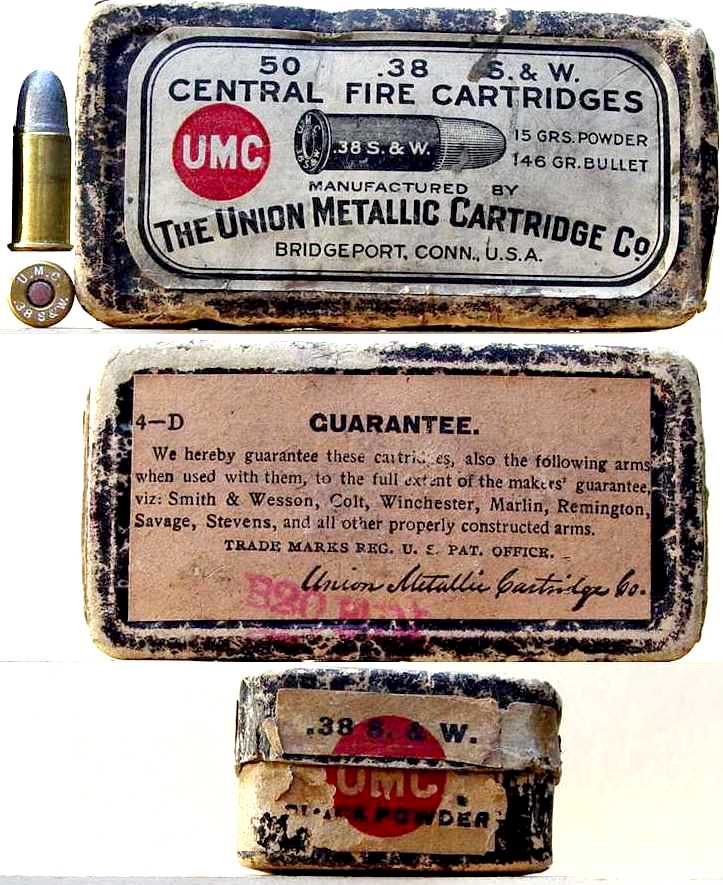 .The
remaining three boxes that I have included here, two by UMC and the last an
early Remington-UMC, all held black powder loads and have variations of the
red-ball logo. The labels of the two UMC boxes no longer state that the
cartridges are inside lubricated, likely because these boxes were made
around 1900 or later. Note the differences in the logos of the UMC boxes,
the second box with the words Trade Mark under the red ball, while the first
box is not so marked, but has 'Trade Marks Reg. U.S. Pat. Office' printed on
the guarantee label on the bottom. Note also the two variations of Colt
(Colt and Colt's) on the guarantee label, both of which are marked 4-D.
.The
remaining three boxes that I have included here, two by UMC and the last an
early Remington-UMC, all held black powder loads and have variations of the
red-ball logo. The labels of the two UMC boxes no longer state that the
cartridges are inside lubricated, likely because these boxes were made
around 1900 or later. Note the differences in the logos of the UMC boxes,
the second box with the words Trade Mark under the red ball, while the first
box is not so marked, but has 'Trade Marks Reg. U.S. Pat. Office' printed on
the guarantee label on the bottom. Note also the two variations of Colt
(Colt and Colt's) on the guarantee label, both of which are marked 4-D. 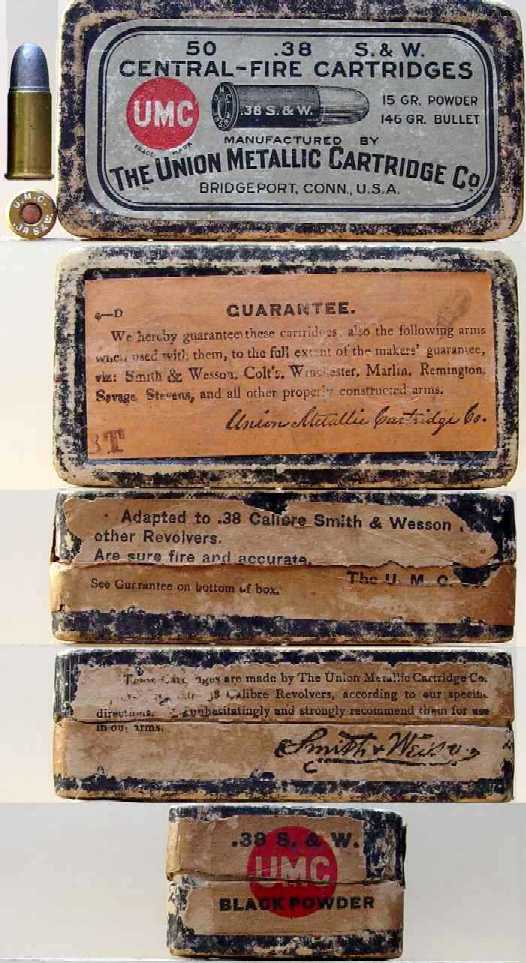
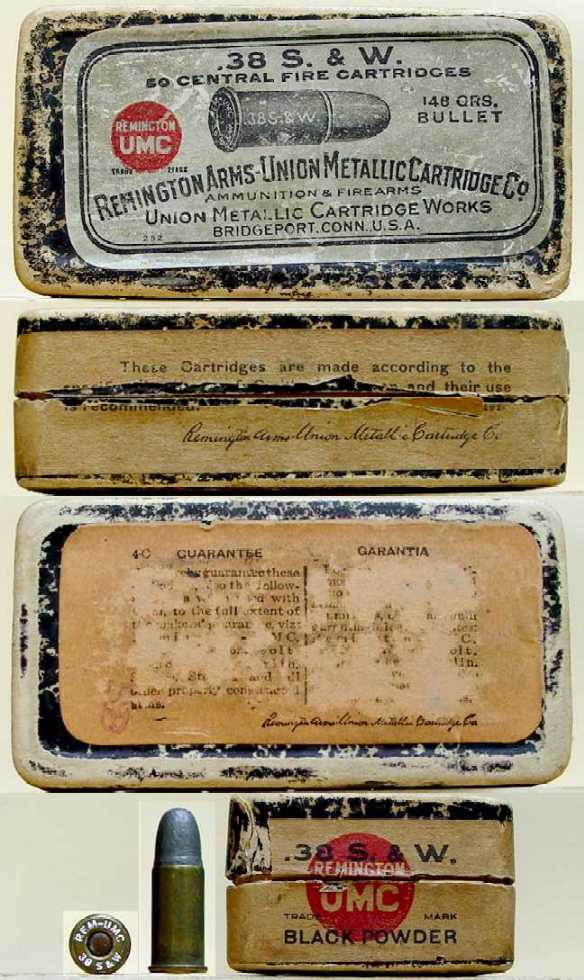
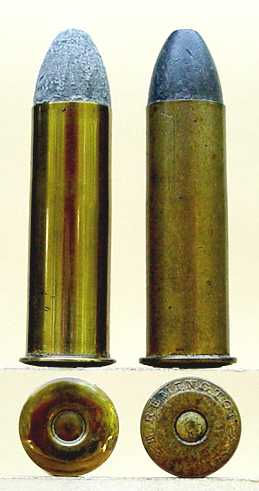
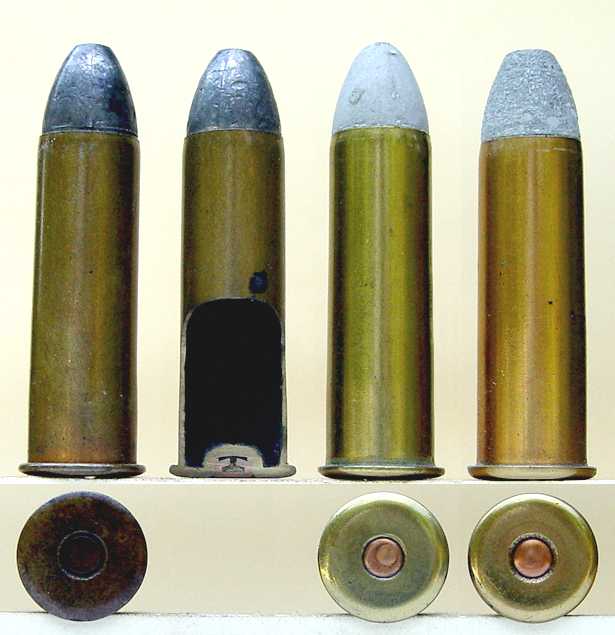 which
appears to have been smeared into the primer pocket, and the rounded type
which looks pretty much like the copper Boxer style primers used by the
other cartridge companies. As can be seen on the sectioned head, the
Farrington primer has no separate anvil, but instead is formed from a single
piece of copper; once the cup is formed, the sides are folded in to form a
base which serves as the anvil. I'm not sure what the purpose of the blister
is on the primer of the third cartridge, but it may be intended to hold the
internal priming compound in place.
which
appears to have been smeared into the primer pocket, and the rounded type
which looks pretty much like the copper Boxer style primers used by the
other cartridge companies. As can be seen on the sectioned head, the
Farrington primer has no separate anvil, but instead is formed from a single
piece of copper; once the cup is formed, the sides are folded in to form a
base which serves as the anvil. I'm not sure what the purpose of the blister
is on the primer of the third cartridge, but it may be intended to hold the
internal priming compound in place. 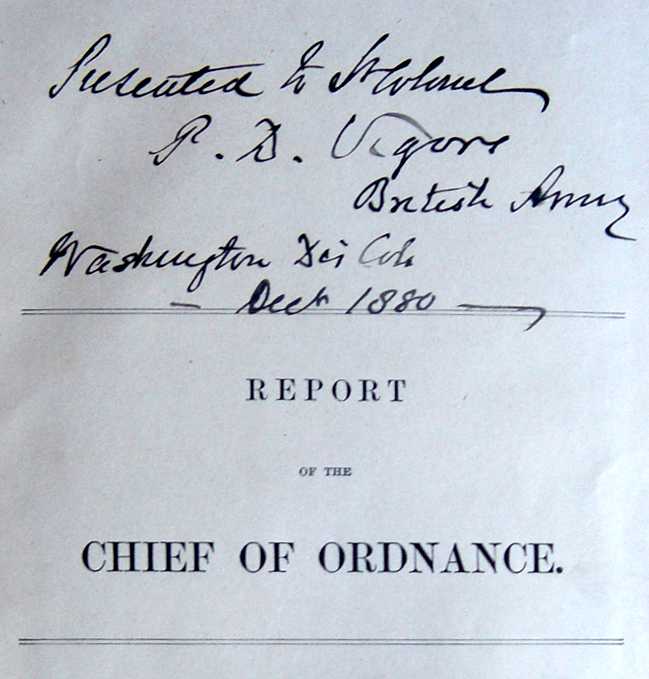 The presentation inscription shown here is on one of my 1878 copies. While there is no
indication as to who presented it, the inscription says "Presented to Lt
Colonel P. D. Vigors British Army Washington Dis Col Decr 1880".
Perhaps there is a story regarding why this British Officer was in
Washington D.C. in 1880, and what occasion prompted the presentation; if
there is, I'd like to hear the details. I don't know much about P.D. Vigors,
other than his full name was Philip Doyne Vigors, he was born in 1825 and
died in 1903, and he had an serious interest in Irish geneology, archeology,
and anthropology.
The presentation inscription shown here is on one of my 1878 copies. While there is no
indication as to who presented it, the inscription says "Presented to Lt
Colonel P. D. Vigors British Army Washington Dis Col Decr 1880".
Perhaps there is a story regarding why this British Officer was in
Washington D.C. in 1880, and what occasion prompted the presentation; if
there is, I'd like to hear the details. I don't know much about P.D. Vigors,
other than his full name was Philip Doyne Vigors, he was born in 1825 and
died in 1903, and he had an serious interest in Irish geneology, archeology,
and anthropology. 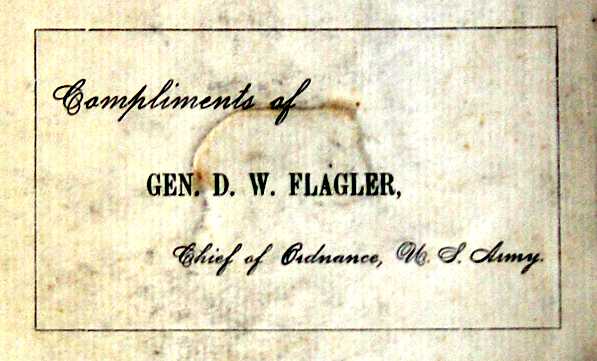 Brigadier General Daniel W. Flagler and is inside the front cover of my 1890
Report. The commanding officer of the Watertown Arsenal that year, he
assumed command of the Ordnance Department after the retirement of General
Steven Vincent Benet in January 1891. Unfortunately, it appears that he
didn't present this volume to anyone, as there is no recipient's name
inscribed in it.
Brigadier General Daniel W. Flagler and is inside the front cover of my 1890
Report. The commanding officer of the Watertown Arsenal that year, he
assumed command of the Ordnance Department after the retirement of General
Steven Vincent Benet in January 1891. Unfortunately, it appears that he
didn't present this volume to anyone, as there is no recipient's name
inscribed in it.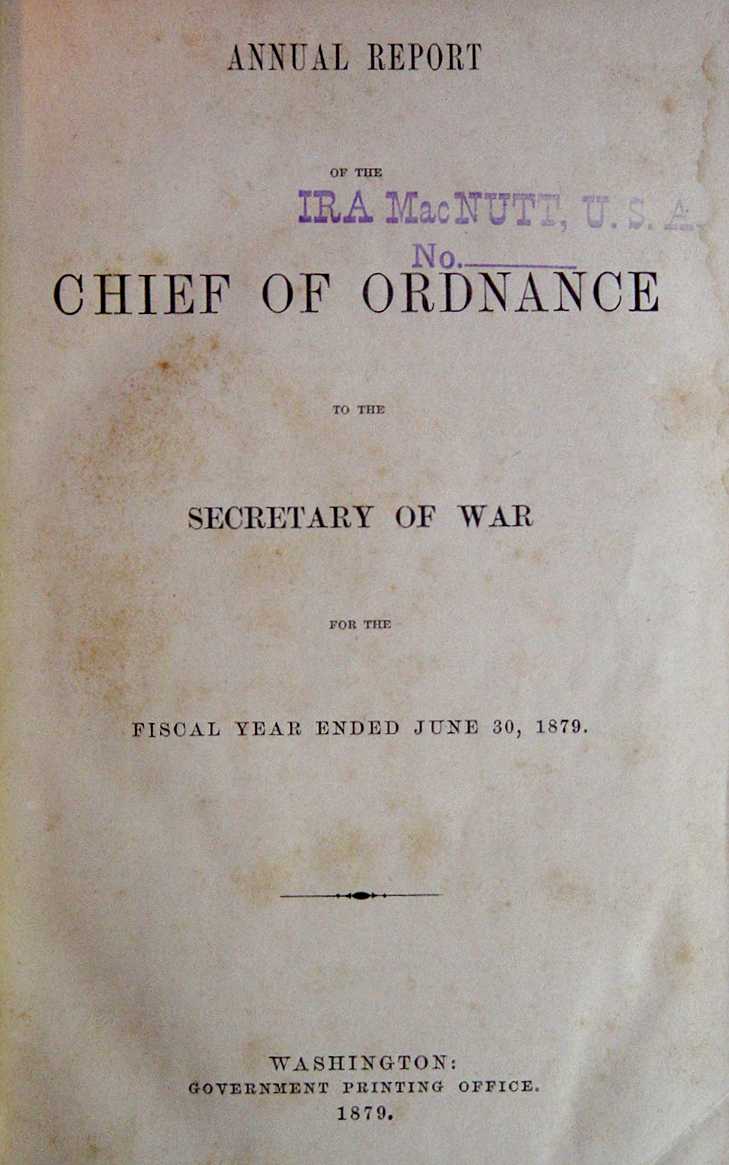 assistant at the Rock Island Arsenal in Illinois in 1878. I would assume
this was his personal copy; what the '101' in the second picture signifies I
don't know - perhaps the 101st book in his library, or his position in the
pecking order of the chain of command. Regardless, Lt. Ira MacNut does have
a place in the history of military ammunition, namely the .45-70 cartridge.
On July 6, 1886, George W. Morse received a patent for a removable base
cartridge case. Apparently, Morse was working on his design for some time
prior to receiving his patent, as the Frankford Arsenal experimented with
removable base cases at least as early as 1884. In January 1886, Frankford
Arsenal was requested to make up a small batch of these cartridges to be
sent to Morse prior to beginning production on a large scale. Lt. Ira
MacNutt and J. H. Gill, inventor of the Gill primer, were involved in
supervising the production of these samples. These are the super rare
pre-production Morse Pattern 1886 cartridges that have the 'MODEL 86'
headstamp; it is believed that at least 50 of these cartridges were
produced.
assistant at the Rock Island Arsenal in Illinois in 1878. I would assume
this was his personal copy; what the '101' in the second picture signifies I
don't know - perhaps the 101st book in his library, or his position in the
pecking order of the chain of command. Regardless, Lt. Ira MacNut does have
a place in the history of military ammunition, namely the .45-70 cartridge.
On July 6, 1886, George W. Morse received a patent for a removable base
cartridge case. Apparently, Morse was working on his design for some time
prior to receiving his patent, as the Frankford Arsenal experimented with
removable base cases at least as early as 1884. In January 1886, Frankford
Arsenal was requested to make up a small batch of these cartridges to be
sent to Morse prior to beginning production on a large scale. Lt. Ira
MacNutt and J. H. Gill, inventor of the Gill primer, were involved in
supervising the production of these samples. These are the super rare
pre-production Morse Pattern 1886 cartridges that have the 'MODEL 86'
headstamp; it is believed that at least 50 of these cartridges were
produced.